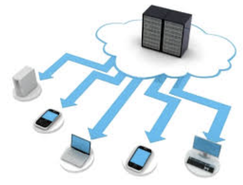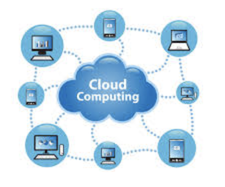As businesses look to modernize their operations and bring more efficiency to their processes, cloud computing is a natural fit. Cloud-based technology has made it possible for organizations of any size or industry to access the same technology resources from anywhere at any time — with just a computer, an internet connection, and a supported browser.
But not everyone can operate efficiently in this digital age. That’s where the best cloud computing companies come in. These enterprises are the driving force behind progress in the industry, continually working to make cloud computing more secure, reliable and cost-effective for businesses of all sizes.
Here’s what you need to know about cloud computing in 2022:
What is cloud computing?
Cloud computing is defined as “the delivery of computer resources on demand, through various channels, and on a pay-as-you-go basis.” Essentially, it is about rethinking how businesses use technology. Instead of having IT operations that are solely located in one physical location, or in a single business, cloud companies are able to use a network of remote servers to provide computing resources to customers.
Because the technology is distributed and accessible via the internet, it is accessible from anywhere. Cloud computing is an ideal fit for companies that have limited resources (both financially and physically). It also makes sense for companies that have a need for a certain amount of flexibility, as the network of remote servers can be configured to meet those needs on a specific day’s notice.
Who are the best cloud computing companies?
Cloud computing is going mainstream and the best cloud companies are winning customers. The Microsoft-IBM partnership to bring cloud offerings to the masses is yielding results. Cloud providers are now able to offer their services at a lower price than in-house IT operations, making them more attractive to private businesses. In order to remain competitive, it’s essential to stay up-to-date with the latest cloud strategies and implement best practices. The best cloud companies understand their customers’ needs, and don’t just blindly follow trends. They are also leaders in their industry, and are continually working to make cloud computing more secure, reliable, and cost-effective for businesses of all sizes.
How do you become a top cloud computing company?
Cloud computing is a rapidly evolving market. In order to succeed in this rapidly changing environment, you must stay on top of industry trends, as well as best practices and emerging technologies. You also need to have a clear vision and a strong business model. Your business model should focus on creating value for your customers.
One of the best ways to do this is to focus on offering services that solve real problems for your industry or category. By doing so, you will be able to better understand the pain points of your customers and provide solutions that solve those problems. Creating a strong brand identity is also key to being a top cloud computing company. A strong brand identity will help you connect with your customers and establish a reputation for providing value that will help you rise above the competition.
Create value for your customers
Building trust with your customers is essential to success in any industry. And as the cloud market segment expands, you’ll need to establish trust with your customers even more. The best cloud computing companies understand this, and are creating value for their customers.
By providing seamless, affordable, and secure cloud services, the best cloud companies are making it easier for businesses to grow, innovate, and succeed. It’s important to remember that you can’t just offer your customers a self-service experience.
You must provide value in other areas as well, such as IT support, security, and operations. This will help you stand out among your competitors and establish trust with your customers.
Secure your data
Cloud services are increasingly being used for sensitive business operations, such as data storage or archiving. While this is not unique to cloud computing, it is an area that is important to focus on in order to stay competitive.
Data security is a significant concern for businesses, especially those operating in regulated industries. The best cloud computing companies understand this, and take it seriously.
They implement strong data security practices and fail closed-door auditing and compliance tests more than once. In doing so, they are helping their customers safeguard sensitive information and avoid fines or other penalties that are often associated with violating regulations.
Build for flexibility and interoperability
Flexibility and interoperability are also important when it comes to staying competitive. These are key components of the software-as-a-service model, which is the most common type of cloud architecture. While it’s important to focus on these areas when it comes to the best cloud computing companies, they are also extremely important when it comes to any type of business.
In order to thrive in a rapidly evolving world, organisations need to be nimble and able to quickly adapt to new situations. When it comes to customers, you must be able to understand their needs, and then quickly provide a solution that meets those needs. It’s also important to remember that the best cloud companies are not just focused on their customers’ current needs. They are also thinking about the future and how they can create value for customers down the road.
Bottom line
Cloud computing has become a critical component of business operations, allowing firms to access a wide range of computing resources from anywhere in the world. The best cloud computing companies are those that offer reliable, flexible, and cost-effective services, while also being secure, compliant, and predictable.
It’s important to remember that the best cloud companies are not just big companies with huge budgets. They’re small businesses, with one to five employees, that are using cloud computing to improve efficiency and build their business. For more information on how you can leverage the benefits of cloud computing, contact the best cloud computing companies to learn more about how they can help you succeed in this rapidly evolving market.


 All businesses should have a disaster recovery plan in place because you never know when something bad is going to happen. Cloud computing can help with this plan because all of your data will be saved in the cloud. This will reduce the expenses that you face with your disaster recovery plan because you will not have to store servers at 2 locations.
All businesses should have a disaster recovery plan in place because you never know when something bad is going to happen. Cloud computing can help with this plan because all of your data will be saved in the cloud. This will reduce the expenses that you face with your disaster recovery plan because you will not have to store servers at 2 locations. The task of management groups will not only be to ensure that every project and department is on track. Management will also need to ensure that their departments and projects are compliant with internal procedures and government regulations. When working with cloud computing, there will often be more work to be done when it comes to compliance.
The task of management groups will not only be to ensure that every project and department is on track. Management will also need to ensure that their departments and projects are compliant with internal procedures and government regulations. When working with cloud computing, there will often be more work to be done when it comes to compliance. Even though most of the well-known cloud service providers have industry certifications and implement the best security standards, storing valuable data on external storage service providers opens up many risks. Utilizing cloud computing means that you have to provide the service provider access to your business data. The ease in accessing cloud services ideally gives fraudsters the ability to look for, identify and exploit vulnerabilities and loopholes within the system. For example, in a multi-tenant cloud system where several users utilize the same server, a hacker might attempt to gain access to data of other people hosted and stored in the same place. However, the chances of this happening are next to nil, and the likelihood of compromise is unlikely.
Even though most of the well-known cloud service providers have industry certifications and implement the best security standards, storing valuable data on external storage service providers opens up many risks. Utilizing cloud computing means that you have to provide the service provider access to your business data. The ease in accessing cloud services ideally gives fraudsters the ability to look for, identify and exploit vulnerabilities and loopholes within the system. For example, in a multi-tenant cloud system where several users utilize the same server, a hacker might attempt to gain access to data of other people hosted and stored in the same place. However, the chances of this happening are next to nil, and the likelihood of compromise is unlikely.